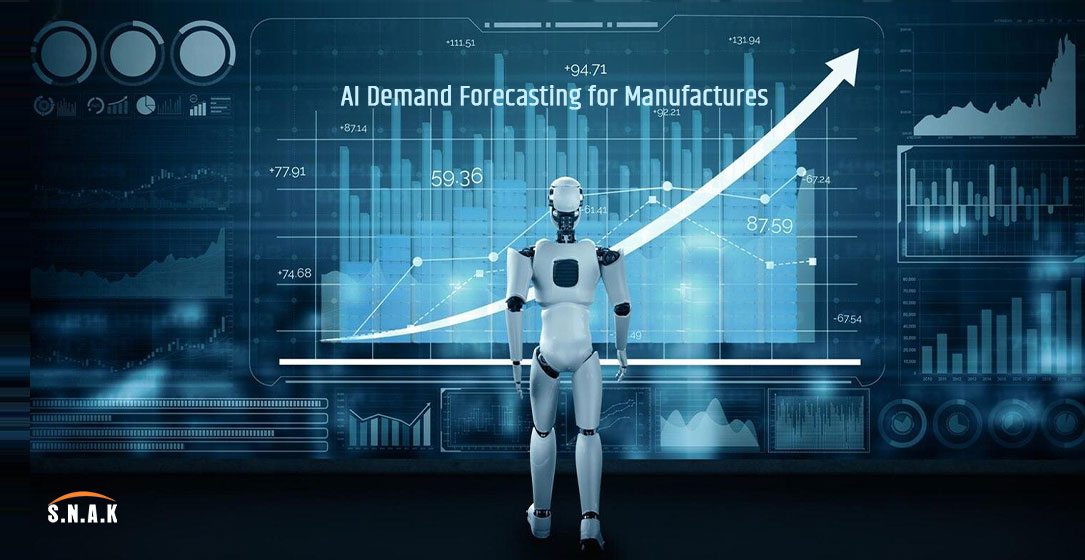October 2, 2025 | SNAK Consultancy
Share on :
AI-Powered Demand Forecasting: Helping Manufacturers Prepare for the Future

Introduction
In today's rapidly evolving manufacturing landscape, staying ahead of customer demand is more challenging—and more critical—than ever. Traditional forecasting methods often fall short in accuracy, leading to overstocking or stockouts that can disrupt operations and erode profits. Enter AI-powered demand forecasting: a transformative approach that leverages advanced algorithms and real-time data to predict customer needs with unprecedented precision. This blog delves into how AI is revolutionizing demand forecasting in manufacturing, helping businesses optimize inventory, reduce costs, and enhance customer satisfaction.
Understanding AI-Powered Demand Forecasting
AI-powered demand forecasting utilizes machine learning (ML) algorithms to analyze vast amounts of data—from historical sales and market trends to external factors like weather patterns and social media sentiment. Unlike traditional methods that rely on static models, AI systems continuously learn and adapt, enabling manufacturers to make more accurate and timely predictions.
Key components of AI-driven demand forecasting include:
1. Predictive Analytics: Analyzing historical data to identify patterns and trends.
2. Real-Time Data Processing: Incorporating live data feeds for up-to-date insights.
3. Advanced Algorithms: Employing neural networks and ensemble methods to enhance prediction accuracy.
Benefits for Manufacturers
1. Enhanced Forecast Accuracy
AI systems can process and analyze complex datasets far more efficiently than traditional methods, leading to more accurate demand predictions. This accuracy helps manufacturers align production schedules with actual market needs, reducing the risk of overproduction or stockouts.
2. Optimized Inventory Management
By accurately predicting demand, AI enables manufacturers to maintain optimal inventory levels. This optimization minimizes storage costs and reduces the capital tied up in excess stock, leading to improved cash flow.
3. Cost Reduction
AI-driven forecasting helps identify inefficiencies in the supply chain, such as excess inventory or underutilized resources. By addressing these inefficiencies, manufacturers can reduce operational costs and improve profitability.
4. Improved Customer Satisfaction
With AI, manufacturers can ensure timely product availability, meeting customer expectations and enhancing satisfaction. This reliability fosters customer loyalty and can lead to increased sales.
5. Agile Supply Chain
AI allows manufacturers to quickly adapt to changes in demand or market conditions. Whether it's a sudden surge in orders or a shift in consumer preferences, AI systems provide the agility needed to respond effectively.
Real-World Applications
Walmart's AI-Driven Distribution Centers
Walmart has integrated AI and robotics into its supply chain to enhance efficiency and reduce waste. By analyzing factors like weather patterns and local events, Walmart's AI systems optimize inventory distribution, ensuring that products are available where and when they're needed most.
Amazon's Predictive Logistics
Amazon employs AI to forecast demand at a granular level, tailoring inventory to specific locations. This approach supports same-day delivery services and improves customer satisfaction by ensuring product availability.
Bausch + Lomb's AI-Enhanced Production
In the pharmaceutical sector, Bausch + Lomb uses AI to predict machinery issues and optimize production schedules. This proactive approach minimizes downtime and ensures a steady supply of products.
Implementing AI in Demand Forecasting
For manufacturers looking to adopt AI-powered demand forecasting, the following steps can facilitate a smooth transition:
1. Data Collection: Gather historical sales data, market trends, and external factors that influence demand.
2. Choose the Right Tools: Select AI forecasting tools that align with your business needs and integrate seamlessly with existing systems.
3. Model Training: Use collected data to train AI models, ensuring they can accurately predict future demand.
4. Continuous Monitoring: Regularly assess the performance of AI models and make adjustments as necessary to maintain accuracy.
5. Scalability: Ensure that the AI system can scale with your business growth and adapt to changing market conditions.
Challenges and Considerations
While the benefits of AI-powered demand forecasting are clear, manufacturers should be aware of potential challenges:
1. Data Quality: The accuracy of AI predictions depends on the quality of the input data. Inaccurate or incomplete data can lead to flawed forecasts.
2. Integration: Implementing AI systems may require significant changes to existing processes and infrastructure.
3. Cost: Initial setup and ongoing maintenance of AI systems can be costly, though the long-term savings often justify the investment.
Questionnaire
Ques 1. What is AI-powered demand forecasting?
Ans. AI-powered demand forecasting uses artificial intelligence and machine learning algorithms to predict customer demand by analyzing historical data, market trends, and external factors in real-time.
Ques 2. How is AI different from traditional forecasting methods?
Ans. Unlike traditional methods that rely on historical averages and static models, AI continuously learns from new data, identifies complex patterns, and adapts to changes in market conditions for more accurate predictions.
Ques 3. Can AI demand forecasting handle seasonal fluctuations?
Ans. Yes. AI models can incorporate seasonal trends, holidays, promotions, and external events to accurately forecast demand during peak or low seasons.
Ques 4. What data is required for AI demand forecasting?
Ans. Manufacturers should collect historical sales data, production schedules, market trends, pricing information, promotional campaigns, and relevant external factors like weather, competitor activity, or social media trends.
Ques. 5. Can AI forecasting help improve customer satisfaction?
Ans. Yes. By predicting demand accurately, manufacturers can avoid stockouts, ensure timely deliveries, and maintain consistent product availability, all of which enhance customer experience and loyalty.
Conclusion
AI-powered demand forecasting is no longer a luxury but a necessity for manufacturers aiming to stay competitive in a dynamic market. By leveraging advanced algorithms and real-time data, manufacturers can achieve more accurate forecasts, optimize inventory, reduce costs, and enhance customer satisfaction. As technology continues to evolve, embracing AI in demand forecasting will be crucial for future success.